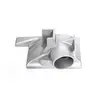Mobile:+86-311-808-126-83
Email:info@ydcastings.com
lost wax casting
The Art and Science of Lost Wax Casting
Lost wax casting, also known as cire perdue, is a time-honored technique that has been utilized for centuries to create metal sculptures, jewelry, and various other artifacts. This fascinating method combines art and science, allowing artisans to transform wax models into intricate metal pieces with remarkable precision. Its rich history and contemporary applications make lost wax casting a captivating subject for artists, craftsmen, and historians alike.
The lost wax casting process begins with creating a model of the desired object out of wax. This initial step is where the artist’s skills come into play. The wax model must be meticulously shaped to capture all the fine details, as any imperfections will be reflected in the final metal piece. Once the model is complete, it is coated with a ceramic shell or a heat-resistant material. This shell will form a mold around the wax model when it hardens.
After the shell is applied, the next stage is to heat the shell in a kiln or furnace. This process causes the wax to melt and drip away, effectively “losing” the wax while leaving behind a hollow mold made of ceramic. The temperature and duration of heating are crucial; they must be carefully controlled to ensure that the shell is sturdy enough to withstand the pouring of molten metal but not so intense that it damages the mold.
With the wax removed, the mold is ready for the metal casting. Molten metal—typically bronze, silver, or gold—is poured into the mold through a designated channel. The temperature and composition of the metal must be precise, as any deviation can lead to imperfections or casting failures. Once the metal has cooled and solidified, the mold is broken away, revealing a metal object that closely resembles the original wax model.
lost wax casting

One of the most significant advantages of lost wax casting is its ability to produce highly detailed and complex shapes that would be difficult to achieve using other casting methods. Each piece is unique, which adds to its intrinsic value, especially in jewelry making and sculpture. This uniqueness has made lost wax casting a favored technique among artists who wish to maintain the individuality of their work.
The history of lost wax casting is rich and varied. It is believed to have been practiced as far back as 3000 BC, with evidence of its use in ancient cultures such as the Egyptians and Mesopotamians. Throughout history, the technique has evolved, but the fundamental principles have remained largely the same. During the Renaissance, the method gained popularity in Europe, particularly among sculptors and craftspeople. Notable artists such as Alberto Giacometti and Henry Moore utilized lost wax casting to create their iconic works.
Today, lost wax casting continues to thrive in various fields, including art, industrial design, and even the medical industry. In modern times, innovations in technology have allowed for the integration of 3D printing into the lost wax process. Artists and manufacturers can now create highly complex and precise wax models with the help of computer-aided design (CAD) software. This advancement expands the creative possibilities for artists while maintaining the integrity and tradition of the lost wax technique.
Despite the advancements in technology, the essence of lost wax casting remains grounded in the artisan's skill and creativity. Each cast piece carries the fingerprint of its maker, reflecting a blend of tradition, artistry, and craftsmanship that is hard to replicate. It serves as a bridge between ancient methodologies and contemporary practices, making it a vital element of our cultural heritage.
In conclusion, lost wax casting is more than just a method of creating metal objects; it is an art form that encapsulates history, innovation, and technique. It brings together artists and craftsmen in a shared pursuit of beauty and precision, allowing them to produce works that resonate with creativity and individuality. As we move forward, the potential for lost wax casting continues to evolve, promising exciting advancements in both artistic expression and manufacturing processes. Whether you are an artist seeking to master this technique or a collector appreciating its beauty and uniqueness, lost wax casting remains a remarkable testament to human creativity and ingenuity.
-
Why Should You Invest in Superior Pump Castings for Your Equipment?NewsJun.09,2025
-
Unlock Performance Potential with Stainless Impellers and Aluminum End CapsNewsJun.09,2025
-
Revolutionize Your Machinery with Superior Cast Iron and Aluminum ComponentsNewsJun.09,2025
-
Revolutionize Fluid Dynamics with Premium Pump ComponentsNewsJun.09,2025
-
Optimizing Industrial Systems with Essential Valve ComponentsNewsJun.09,2025
-
Elevate Grid Efficiency with High-Precision Power CastingsNewsJun.09,2025











